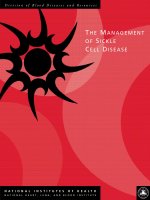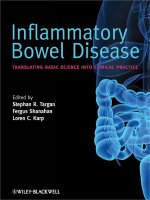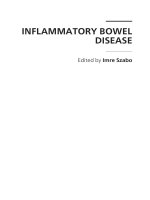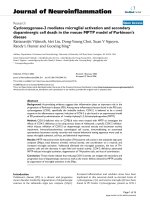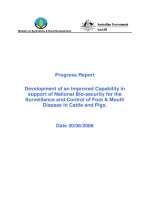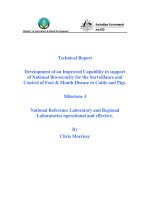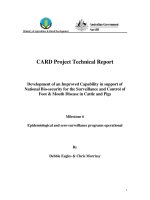the 10 remaining ysteries of inflammatory bowel disease 2008
Bạn đang xem bản rút gọn của tài liệu. Xem và tải ngay bản đầy đủ của tài liệu tại đây (174.01 KB, 6 trang )
doi:10.1136/gut.2007.122192
2008;57;429-433; originally published online 13 Dec 2007; Gut
Jean-Frédéric Colombel, Alastair J M Watson and Markus F Neurath
bowel disease
The 10 remaining mysteries of inflammatory
/>Updated information and services can be found at:
These include:
References
/>This article cites 90 articles, 25 of which can be accessed free at:
service
Email alerting
the top right corner of the article
Receive free email alerts when new articles cite this article - sign up in the box at
Topic collections
(328 articles) Editor's choice
Articles on similar topics can be found in the following collections
Notes
/>To order reprints of this article go to:
/> go to: GutTo subscribe to
on 11 August 2008 gut.bmj.comDownloaded from
The 10 remaining mysteries of
inflammatory bowel disease
Jean-Fre´de´ric Colombel,
1
Alastair J M Watson,
2
Markus F Neurath
3
Tremendous progress has been made in
our understanding of the pathobiology of
inflammatory bowel disease (IBD:
Crohn’s disease (CD) and ulcerative colitis
(UC)) through research on mouse models
of gut inflammation, human population
genetics studies and immunological
research.
1–4
However, despite these impor-
tant advances, many of the primary
features of human IBD remain unex-
plained.
In this article we pose a series of 10
fundamental questions about the epide-
miology and clinical course of IBD that
remain unanswered to this day. In order
to obtain ‘‘best guess’’ answers to these
questions, we have interviewed experts
who are leaders in the field of each
question. This article is a distillation of
their opinions which we hope will refocus
future research onto these remaining
mysteries (Box 1) which are essential for
improving the clinical management of
IBD.
WHAT EXPLAINS THE GEOGRAPHICAL
AND HISTORICAL VARIATION IN THE
INCIDENCE OF IBD?
The incidence of IBD has risen sharply in
the last 50 years in the USA and western
European countries; with the increase
occurring in higher social classes before
lower social classes.
56
The increase in
incidence is too rapid to be accounted for
by genetic changes and strongly points to
changes in environmental risk factors,
especially changes in diet and intestinal
microflora.
7
In Japan, a correlation between
incidence of IBD and fat and meat intake
has been reported.
8
Changes in diet and
food preparation could influence intestinal
microflora. Large variations in the range of
bacterial lineages within the intestines of
different individuals have been reported.
9
However, the relationship between the
microbial community structure within
the gut and IBD is unknown. New
concepts that intestinal microbiota exist
in a finely balanced ecosystem in which
changes to one microbial species influences
other species suggest that ideas that IBD is
caused by a single microbial species may be
oversimplistic.
10
The advent of refrigeration in the early
20th century promoting Yersinia and
Listeria spp in food has been proposed to
account for the rise in IBD.
11
Certain
Escherichia coli strains are also associated
with CD, though their relationship to food
is not known.
12
Debates and investigations
continue into a putative aetiological role
for mycobacteria despite the paucity of
compelling evidence to support this
hypothesis.
13
The ‘‘hygiene’’ hypothesis
proposes that lack of stimulation of the
immune system by environmental micro-
organisms and antigens in childhood may
predispose to IBD.
14
Commensal gut organ-
isms can stimulate regulatory T cells and
prevent IBD in a mouse model.
15
Further
support for changes in intestinal microflora
comes from the observation that antibiotic
use is associated with the onset of CD.
16
WHY IS APPENDICITIS ASSOCIATED
WITH A REDUCED RISK OF UC?
Appendicitis protects against UC. It may
also be a risk factor for CD, although this
may be explained by diagnostic bias.
17–19
Appendicitis became common in the 19th
century, peaked in the 1950s and is now
in decline, while the incidence of UC
increased between the 1950s and the
1980s but has now stabilised. Changes in
diet with consequent changes in intestinal
microflora over the last 150 years may
have initially favoured appendicitis but
now favour UC. The appendix contains
gut-associated lymphoid tissue and is a
site for B cell priming and development,
and may play a role in priming B cells
against luminal bacteria.
20 21
In a mouse
model of UC, appendicectomy prevents
colonic inflammation by reducing produc-
tion of antibodies against the cytoskeletal
protein tropomyosin expressed on colo-
nocytes.
22
It is known that lamina propria
B cells in UC produce tropomyosin anti-
bodies.
23
Thus it can be proposed that the
appendix is an important site for priming
B cells through molecular mimicry
between microbial peptides and tropo-
myosin.
24
It should be noted, however,
that a role for autoimmunity in UC
remains unproven. A second hypothesis
is that a susceptibility gene for UC may be
closely linked to a protective gene for
appendicitis, or vice versa. Another possi-
bility is that UC is more likely in
individuals who mount a Th2-polarised
response, whereas appendicitis may be
more likely in those who mount a Th1-
polarised response.
25 26
1
Hoˆpital Claude Huriez, Centre Hospitalier Universitaire
de Lille, Lille, France;
2
School of Clinical Sciences,
University of Liverpool, Liverpool, UK;
3
First Medical
Clinic, University of Mainz, Mainz, Germany
Correspondence to: Professor Alastair Watson, School
of Clinical Sciences, The Henry Wellcome Laboratory,
Nuffield Building, University of Liverpool, Crown Street,
Liverpool L69 3BX, UK;
Box 1 The 10 remaining mysteries of inflammatory bowel disease
c What explains the geographical and historical variation in the incidence of inflammatory
bowel disease?
c Why is appendicitis associated with a reduced risk of ulcerative colitis?
c Why does smoking exacerbate Crohn’s disease but protects against ulcerative colitis?
c Why is the inflammation of Crohn’s disease transmural and that of ulcerative colitis
confined to the mucosa, and how does it drive cancer?
c Are ulcerative colitis and Crohn’s disease distinct disorders or part of a continuum?
c Why does Crohn’s disease have skip lesions down the entire gastrointestinal tract?
c What is the role of extraluminal structures (mesenteric fat, vasculature, lymphatics) in
Crohn’s disease?
c What are the factors that determine the timing of the initial attack of inflammatory
bowel disease and subsequent relapses?
c Why does postoperative recurrence of Crohn’s disease usually occur in the neo-terminal
ileum?
c Why are certain extraintestinal manifestations linked to the evolution of inflammatory
bowel disease and some are independent?
Leading article
Gut April 2008 Vol 57 No 4 429
on 11 August 2008 gut.bmj.comDownloaded from
WHY DOES SMOKING EXACERBATE CD
BUT PROTECTS AGAINST UC?
27
A number of plausible hypotheses have
been proposed to answer this question
but none has been proven. This dichot-
omy may simply be a result of smoking
having different effects on the small and
large intestine.
28
In CD, macrophage
dysfunction and impaired phagocytosis
may play a pathogenic role.
2
Pulmonary
macrophages from smokers have impaired
killing of intracellular bacteria, raising the
possibility that smoking also impairs
macrophage function in the gut.
29
Carbon monoxide from smoking may
augment microvascular abnormalities
documented in CD.
30 31
Inadequate apop-
tosis of T cells contributes to the persis-
tent inflammatory responses of CD,
though this may be a feature of any
chronic inflammatory response.
32 33
Nitrosamine 4-(methylnitrosamino)-1-(3-
pyridyl)-1-butanone (NNK), the most
potent carcinogen in cigarette smoke,
may further inhibit T cell apoptosis
through phosphorylation of bcl-2 and
myc.
34
In contrast, in UC excessive apop-
tosis of colonic epithelial cells may be a
significant factor.
35
In this case, the
antiapoptotic effects of cigarette smoke
would be beneficial. Carbon monoxide is
known to have anti-inflammatory effects
mediated by interleukin (IL) 10 but is also
beneficial in the IL10 knockout mouse
model of colitis via a mechanism invol-
ving the induction of haem-oxidase-1.
36 37
Further beneficial effects may be via
increasing mucin production,
38
reducing
expression of IL8
39
or inhibiting tumour
necrosis factor (TNF) production.
37
Overall, the effect of smoking on IBD
may be the sum of contradictory effects
exacerbating chronic inflammation via
impaired vascular perfusion but improv-
ing acute colitis.
WHY IS THE INFLAMMATION OF CD
TRANSMURAL AND THAT OF UC
CONFINED TO THE MUCOSA, AND HOW
DOES IT DRIVE CANCER?
It is stated in the majority of IBD
textbooks that CD causes a transmural,
granulomatous gut inflammation,
whereas inflammation in UC is restricted
to the mucosa. The pathologists in the
expert panel did not feel this dogma was
true,
40 41
as CD may be limited to mucosal
aphthoid lesions and severe UC may cause
submucosal or even transmural inflam-
mation (eg, toxic megacolon). However,
there was general consensus that CD
inflammation frequently goes further into
the mucosa than UC inflammation. The
experts suggests that this observation is
due to the fundamentally different aetiol-
ogy of the two diseases.
14243
One scenario
suggests that UC is a disease of the
epithelium (possibly of autoimmune ori-
gin) that drives inflammation close to the
epithelial cell layer, whereas CD is a
disease of the mucosal barrier in a
genetically susceptible host that results
in activation of the innate and later
adaptive mucosal immune systems in
deeper layers of the gut.
42 44
Other experts
suggested that in CD, but not UC,
intestinal phagocytes fail to kill or neu-
tralise the invading pathogens, thereby
causing a perpetuated translocation of
bacteria into the bowel wall (possibly
through altered barrier function or the
defective autophagy genes ATG16L1 and
IRGM
45
). Thus CD may bear analogies to
a localised infection that progresses into
the bowel wall until the infection is at
least partially controlled by the mucosal
immune system. Other ideas include
defective mucosal antiprotease activity in
CD but not UC,
46
lymphatic obstruction
in CD but not UC, and different types of
bacteria causing CD and UC (eg, adhesive
bacteria causing superficial inflammation
in UC vs more invasive bacteria in CD
47
).
Remarkable recent observations high-
light the importance of bacterial flora in
UC. Mice lacking both lymphocytes and
T-bet, a transcription factor that regulates
immune cell differentiation and function,
develop colonic inflammation that closely
mimics UC. This is mediated by TNF
production and loss of intestinal epithelial
barrier function. Microbial flora from
such mice cause a similar colitis when
given to mice with a normal immune
system, demonstrating that the host
immune response can modify the intest-
inal microbial ecosystem so that it
becomes colitogenic.
48
Finally, debate remains as to whether
cancer risk is greater in UC than CD. If
one assumes that UC causes cancer
development frequently,
49
potential rea-
sons comprise the primary epithelial
origin of UC with frequent ulcer forma-
tion that may cause proliferation, oxida-
tive stress and DNA damage in epithelial
cells. In this way, the inflammation
together with primary epithelial defects
may trigger carcinogenesis in UC,
50
the
risk factors being flare frequency and
extent of disease.
ARE UC AND CD DISTINCT DISORDERS
OR PART OF A CONTINUUM?
The different distributions of inflamma-
tion along the gastrointestinal (GI) tract
in UC and CD suggest they may have
different disease mechanisms. The oppo-
site effects of smoking on UC and CD
lend further support. The concept that
UC is always confined to the colon was
disputed by our expert pathologists. In
fact, severe UC may cause backwash
ileitis, and UC in some children may
result in superficial mucosal inflammation
of the entire small intestine or duodeni-
tis.
51
Furthermore, UC in children can be
associated with diffuse and focally
enhanced Helicobacter pylori-negative gas-
tritis.
52
It is thus possible that UC (at least
in a subgroup of patients) starts as a more
widespread disease with upper and lower
GI involvement and that the lesions in the
upper GI tract disappear while those in
the lower GI tract persist.
There is genetic evidence that extensive
UC may be a distinct disease subgroup of
UC as IBD2 is associated with extensive
UC but not distal disease.
53
The tendency
for UC to be confined to the colon in
contrast to CD may have several rea-
sons.
35 54
(1) In UC the changes in immune
response may be sufficiently subtle that the
trigger required for inflammation can only
be provided by the large bacterial load in
the colon. In contrast, a far less intense
trigger may be required for CD and so can
occur anywhere in the GI tract. (2) UC
originates from the rectum as this region
may be most conducive to the induction of
the cytokine milieu necessary for patholo-
gical natural killer (NK) T cell development
(eg, IL13
35
) and colonic, but not small
intestinal epithelial cells, may produce
UC-inducing cytokines. (3) Differences in
the vasculature, mucus production or the
commensal microflora between the colon
and small intestine could cause the regional
differences in UC and CD. (4) Differences
in the expression of receptors for disease-
causing antigens could be present between
the colon and the small intestine (eg,
pathogen-associated molecular patterns,
Toll-like receptors), thereby preventing
Experts contributing to this article
Ted Bayless, Baltimore; Richard
Blumberg, Boston; Jacques Cosnes,
Paris; Geert D’Haens, Leuven; Anders
Ekbom, Stockholm; Morten Frisch,
Copenhagen; Karel Geboes, Leuven;
Hans Herfarth, Chapel Hill; Derek Jewell,
Oxford; Herbert Van Kruiningen, Hartford;
Laurent Peyrin-Biroulet, Lille; Daniel
Podolsky, Boston; Graham Radford-
Smith, Brisbane, Jonathan Rhodes,
Liverpool; Robert Riddell, Toronto; David
Sachar, New York; Juergen Schoelmerich,
Regensburg; Eduard Stange, Stuttgart;
Warren Strober, Bethesda.
Leading article
430 Gut April 2008 Vol 57 No 4
on 11 August 2008 gut.bmj.comDownloaded from
small intestinal inflammation. (5) Genetic
predispositions in UC may affect genes
that are mainly expressed and functionally
relevant in the colon. The sharp demarca-
tion between involved and uninvolved
areas in UC is an endoscopic observation
but may not be reflected by histology in all
patients. Furthermore, the concept of con-
tinuous inflammation in UC may not be
true in all patients, since there can be rectal
sparing in subgroups of UC patients (eg,
PSC-IBD
55
), leading to absence of contin-
uous mucosal inflammation of the colon.
WHY DOES CD HAVE SKIP LESIONS
DOWN THE ENTIRE GI TRACT?
The discontinuous inflammation of the
GI tract with skip lesions has been
described as a hallmark feature of CD.
Segmental mucosal inflammation is char-
acteristic of many infectious forms of
colitis (eg, tuberculosis, cytomegalovirus
infection, amoebiasis). CD might be con-
sidered as an atypical infectious disease in
which the host responds inappropriately
to some elements of the commensal
microflora.
42 44 56 57
The segmental nature
of inflammation in CD could therefore be
due to the topology of the commensal
microflora colonisation and the topology
of the immune response (eg, receptor
expression levels) and their mutual inter-
actions. This concept is supported by the
finding that different bacterial species
cause inflammation in different segments
of the GI tract in IL10-deficient mice.
58
Other factors such as the segmental
nature of the vascular and nerve supply,
regional variation in lymphatics and M
cells, stasis of luminal contents, deficiency
in a-defensin in the ileum
59
and the
production of mediators that prevent
lateral spreading of disease could all
contribute to the development of skip
lesions in CD. Recent studies of genetic
polymorphisms suggest that ileal and
colonic disease may be distinct. The
majority of patients with single nucleo-
tide polymorphisms that associate with
CD have ileal disease. The exception to
this is that IBD5 has been reported to be
associated with perianal disease in CD.
60
WHAT IS THE ROLE OF EXTRALUMINAL
STRUCTURES (MESENTERIC FAT,
VASCULATURE, LYMPHATICS) IN CD?
It is generally believed that changes in
extraluminal structures are just markers
of transmural inflammation. However,
there is evidence that mesenteric fat and
vasculature participate in the pathogen-
esis of CD. Mesenteric fat hypertrophy is
a hallmark of CD.
61–63
It is an important
source of TNFa, which could explain the
location of mucosal ulcerations along the
mesenteric border.
64
Adipocytes express
C-reactive protein (CRP) and there is a
significant correlation between serum
CRP levels and increased mesenteric fat
density in CD.
65
Mesenteric fat may also
contribute to innate immunity by limit-
ing intestinal bacterial translocation, as
illustrated by increased adiposity follow-
ing viral infection and its expression of
NOD2 and Toll-like receptors.
63
The
hypothesis that the primary pathological
abnormality in CD is in the mesenteric
blood supply has not been confirmed.
30
Whether increased vascularisation as
assessed by mesenteric angiography or
Doppler ultrasound reflects CD activity
is disputed.
66
Recent evidence for angio-
genesis playing a role in IBD pathogenesis
has prompted interest in antiangiogenic
therapies for IBD.
67 68
Finally, the micro-
scopic appearance and distribution of CD
lesions strongly suggests that lymphangi-
tis plays a role in the pathology of CD.
69 70
This has been almost completely ignored
in the recent literature. Once rediscovered,
aetiologists may choose to focus their
attention on agents that target the
lymphatic endothelium.
WHAT ARE THE FACTORS THAT
DETERMINE THE TIMING OF THE INITIAL
ATTACK OF IBD AND SUBSEQUENT
RELAPSES?
It is difficult to determine when IBD
actually starts, as significant inflamma-
tion can be present before there is
sufficient luminal compromise or sys-
temic effects to cause symptoms.
Increased intestinal permeability and
appearance of serological markers have
been shown to precede the development
of overt CD.
71 72
What then triggers the
first symptomatic ‘‘attack’’? CD often
occurs at a time in life when teenagers
and young adults are at risk for several
infectious diseases, including, tonsillitis,
appendicitis, mononucleosis and
Hodgkin’s disease. This is also the time
when the Peyer’s patches and lymphoid
follicles of the small intestine ‘‘the tonsils
of the lower intestine’’ are at their great-
est number and probably at their greatest
activity.
73
The initial insult may be an
enteric virus entering Peyer’s patches in a
susceptible host. Relapses can occur after
the withdrawal of medication, especially
if there is evidence of continued inflam-
mation such as elevated sedimentation
rate, CRP or mucosal concentration of
TNF.
74 75
There have been a number of
reports of seasonality of relapses of IBD.
76
Flare-ups may be induced by viruses other
than that which may have initiated the
disease, or by bacteria.
77 78
Animal and
clinical epidemiological studies also lend
support for psychological stress contribut-
ing to relapse in IBD, though some studies
have been flawed by poor design and
analysis.
79
WHY DOES POSTOPERATIVE
RECURRENCE OF CD USUALLY OCCUR IN
THE NEO-TERMINAL ILEUM?
Observational studies have demonstrated
that CD recurs in up to 90% of patients in
the years following ‘‘curative’’ surgery.
80 81
In the case of ileocolonic anastomosis, the
vast majority of recurrences take place in
the neo-terminal ileum, just proximal to
the anastomosis.
80 81
Resection usually
removes the ileocaecal valve, creating the
potential for the contents of the colon to
be shared with the neo-terminal ileum.
Recurrence may just be the consequence
of increased exposure of susceptible
Peyer’s patches to luminal agents. After
ileocolectomy, bacterial colonisation of
the neo-terminal ileum is increased.
82
Primary ileostomies have a lower risk of
recurrence than ileocolonic anastomosis.
83
Reinfusion studies have shown that when
ileal fluid is infused across an ileocolonic
anastomosis via double-loop ileostomy,
signs of inflammation appear within
1 week, but only if the fluid contains
bacteria.
84 85
Surgical resection inevitably
interrupts lymphatics at the site where
the anastamosis is performed. The intest-
inal segment proximal to where the
resection was performed may, in fact,
have lymphangitis.
86
The resulting oede-
matous Peyer’s patches and localised
lymphangiectasia could be prime sites for
recurrence and microbial-induced fissures
and fistulae.
69
Another factor is the
specific role of particular bacterial sub-
populations. An increased number of
adherent invasive E coli adhere to the ileal
mucosa of patients with CD both before
and after surgery.
87
This results in
increased expression of CEACAM6, a
protein known to enhance bacterial adhe-
sion, including adherent invasive E coli.
88
A
deficiency of a-defensin in the ileum may
be a further localising factor.
59
WHY ARE CERTAIN EXTRAINTESTINAL
MANIFESTATIONS LINKED TO THE
EVOLUTION OF IBD AND SOME ARE
INDEPENDENT?
The most common extraintestinal mani-
festations (EIMs) relate to the joints and
eyes, along with some skin manifestations
such as erythema nodosum and pyoderma
gangrenosum.
89
The aetiology of EIMs is
Leading article
Gut April 2008 Vol 57 No 4 431
on 11 August 2008 gut.bmj.comDownloaded from
thought to be a combination of genetic
predisposition and exposure to luminal
bacterial content. The relationship of
some EIMs to disease activity may be
the result of more bacterial antigens being
presented to the systemic immune system
because of increased intestinal permeabil-
ity during active disease.
89
A strong
association has been observed between
EIMs involving the joints and eyes and
the human leucocyte antigen (HLA) locus
on the short arm of chromosome 6.
90
For
instance, peripheral arthritis is more
frequent in patients with HLA-
DRB1*0103.
91
As major histocompatibility
complex (MHC) class II molecules are
involved in antigen presentation, this
association further suggests a key role
for luminal antigens in the pathogenesis
of these EIMs. In contrast, the progress of
ankylosing spondylitis (AS) is indepen-
dent of the activity of bowel disease.
There is a strong genetic component in AS
which is conferred by HLA-B*27. Bacteria
may be important in the initiation of IBD-
associated AS, but once the disease has
started it runs its course independently.
There is also a lack of association between
the severity of IBD and the likelihood of
developing primary sclerosing cholangitis
(PSC).
92
Bacteria have not been convin-
cingly demonstrated to play a pathogenic
role. It has been proposed that PSC could
be mediated by long-lived memory T cells
incorrectly expressing CCL25, causing
them to home to hepatic endothelium in
the absence of active IBD.
93
CONCLUSION
Astonishing advances have been made in
our understanding of IBD in recent years,
and it would not have been possible to
contemplate answering the questions
posed above 10 years ago. Nevertheless,
these apparently simple questions remain
substantially unsolved. Our panel of
experts have provided extraordinarily
wide-ranging and authoritative opinions
on the answers to our questions. We
sincerely thank them and apologise if we
have not fully reflected their views. We
have tried to be provocative in this article
in order to open new avenues of research,
and we welcome feedback, especially from
readers who disagree with our views on
IBD.
Modern therapy, especially biological
therapy, is both expensive and potentially
dangerous, and yet only a subgroup of
IBD patients gain significant clinical
benefit.
94
We have little idea how to select
and predict response to therapy in indivi-
dual patients. We believe that in answer-
ing our 10 questions, significant advances
will be made towards making personalised
medicine for IBD a clinical reality. IBD
research is now exceptionally dynamic,
and we hope that in 10 years time the true
answers to our questions will become
available.
Competing interests: None.
Revised 27 October 2007
Accepted 13 November 2007
Published Online First 13 December 2007
Gut 2008;57:429–433. doi:10.1136/gut.2007.122192
REFERENCES
1. Xavier RJ, Podolsky DK. Unravelling the
pathogenesis of inflammatory bowel disease. Nature
2007;448:427–34.
2. Wellcome Trust Case Control Consortium.
Genome-wide association study of 14,000 cases of
seven common diseases and 3,000 shared controls.
Nature 2007;447:661–78.
3. Duerr RH, Barmada MM, Zhang L, et al. Evidence for
an inflammatory bowel disease locus on chromosome
3p26: linkage, transmission/disequilibrium and
partitioning of linkage. Hum Mol Genet
2002;11:2599–606.
4. Parkes M, Barrett JC, Prescott NJ, et al. Sequence
variants in the autophagy gene IRGM and multiple
other replicating loci contribute to Crohn’s disease
susceptibility. Nat Genet 2007;39:830–2.
5. Russel MG. Changes in the incidence of
inflammatory bowel disease: what does it mean?
Eur J Intern Med 2000;11:191–196.
6. Danese S, Sans M, Fiocchi C. Inflammatory bowel
disease: the role of environmental factors. Autoimmun
Rev 2004;3:394–400.
7. Shoda R, Matsueda K, Yamato S, et al. Epidemiologic
analysis of Crohn disease in Japan: increased dietary
intake of n-6 polyunsaturated fatty acids and animal
protein relates to the increased incidence of Crohn
disease in Japan. Am J Clin Nutr 1996;63:741–5.
8. Sakamoto N, Kono S, Wakai K, et al. Dietary risk
factors for inflammatory bowel disease: a multicenter
case–control study in Japan. Inflamm Bowel Dis
2005;11:154–63.
9. Ley RE, Turnbaugh PJ, Klein S, et al. Microbial
ecology: human gut microbes associated with
obesity. Nature 2006;444:1022–3.
10. Turnbaugh PJ, Ley RE, Hamady M, et al. The human
microbiome project. Nature 2007;449:804–10.
11. Hugot JP, Alberti C, Berrebi D, et al. Crohn’s disease:
the cold chain hypothesis. Lancet 2003;362:2012–5.
12. Rhodes JM. The role of Escherichia coli in
inflammatory bowel disease. Gut 2007;56:610–2.
13. Peyrin-Biroulet L, Neut C, Colombel JF.
Antimycobacterial therapy in Crohn’s disease: game
over? Gastroenterology 2007;132:2594–8.
14. Garn H, Renz H. Epidemiological and immunological
evidence for the hygiene hypothesis. Immunobiology
2007;212:441–52.
15. Di Giacinto C, Marinaro M, Sanchez M, et al.
Probiotics ameliorate recurrent Th1-mediated murine
colitis by inducing IL-10 and IL-10-dependent TGF-
beta-bearing regulatory cells. J Immunol
2005;174:3237–46.
16. Card T, Logan RF, Rodrigues LC, et al. Antibiotic use
and the development of Crohn’s disease. Gut
2004;53:246–50.
17. Andersson RE, Olaison G, Tysk C, et al.
Appendectomy and protection against ulcerative
colitis. N Engl J Med 2001;344:808–14.
18. Andersson RE. Inverse association between
appendectomy and ulcerative colitis. Surgery
2002;131:472; author reply 472–3.
19. Kaplan GG, Pedersen BV, Andersson RE, et al. The
risk of developing Crohn’s disease after an
appendectomy: a population-based cohort study in
Sweden and Denmark. Gut 2007.
20. Kawachiya T, Oshitani N, Jinno Y, et al. Significance
of increased proliferation of immature plasma cells in
the appendix of patients with ulcerative colitis.
Int J Mol Med 2005;15:417–23.
21. Fujihashi K, McGhee JR, Lue C, et al. Human
appendix B cells naturally express receptors for and
respond to interleukin 6 with selective IgA1 and IgA2
synthesis. J Clin Invest 1991;88:248–52.
22. Mizoguchi A, Mizoguchi E, Chiba C, et al. Role of
appendix in the development of inflammatory bowel
disease in TCR-alpha mutant mice. J Exp Med
1996;184:707–15.
23. Sakamaki S, Takayanagi N, Yoshizaki N, et al.
Autoantibodies against the specific epitope of human
tropomyosin(s) detected by a peptide based enzyme
immunoassay in sera of patients with ulcerative colitis
show antibody dependent cell mediated cytotoxicity
against HLA-DPw9 transfected L cells. Gut
2000;47:236–41.
24. Kovvali G, Das KM. Molecular mimicry may
contribute to pathogenesis of ulcerative colitis. FEBS
Lett 2005;579:2261–6.
25. Mudter J, Neurath MF. Il-6 signaling in inflammatory
bowel disease: pathophysiological role and clinical
relevance. Inflamm Bowel Dis 2007;13:1016–23.
26. Ruber M, Berg A, Ekerfelt C, et al. Different cytokine
profiles in patients with a history of gangrenous or
phlegmonous appendicitis. Clin Exp Immunol
2006;143:117–24.
27. Thomas GA, Rhodes J, Green JT. Inflammatory
bowel disease and smoking—a review.
Am J Gastroenterol 1998;93:144–9.
28. Karban A, Eliakim R. Effect of smoking on
inflammatory bowel disease: is it disease or organ
specific? World J Gastroenterol 2007;13:2150–2.
29. King TE, Jr., Savici D, Campbell PA. Phagocytosis
and killing of Listeria monocytogenes by alveolar
macrophages: smokers versus nonsmokers. J Infect
Dis 1988;158:1309–16.
30. Wakefield AJ, Sawyerr AM, Dhillon AP, et al.
Pathogenesis of Crohn’s disease: multifocal
gastrointestinal infarction. Lancet 1989;2:1057–62.
31. Hatoum OA, Binion DG, Otterson MF, et al. Acquired
microvascular dysfunction in inflammatory bowel
disease: loss of nitric oxide-mediated vasodilation.
Gastroenterology 2003;125:58–69.
32. Watson AJ. In vivo single-photon emission
computed tomography imaging of apoptosis in
Crohn’s disease and anti-tumour necrosis factor
therapy. Gut 2007;56:461–3.
33. Boirivant M, Marini M, Di Felice G, et al. Lamina
propria T cells in Crohn’s disease and other
gastrointestinal inflammation show defective CD2
pathway-induced apoptosis. Gastroenterology
1999;116:557–65.
34. Jin Z, Gao F, Flagg T, Deng X. Tobacco-specific
nitrosamine 4-(methylnitrosamino)-1-(3-pyridyl)-1-
butanone promotes functional cooperation of Bcl2 and
c-Myc through phosphorylation in regulating cell
survival and proliferation. J Biol Chem
2004;279:40209–19.
35. Heller F, Florian P, Bojarski C, et al. Interleukin-13 is
the key effector Th2 cytokine in ulcerative colitis that
affects epithelial tight junctions, apoptosis, and cell
restitution. Gastroenterology 2005;129:550–64.
36. Hegazi RA, Rao KN, Mayle A, et al. Carbon monoxide
ameliorates chronic murine colitis through a heme
oxygenase 1-dependent pathway. J Exp Med
2005;202:1703–13.
37. Sadis C, Teske G, Stokman G, et al. Nicotine protects
kidney from renal ischemia/reperfusion injury through
the cholinergic anti-inflammatory pathway. PLoS ONE
2007;2:e469.
38. Finnie IA, Campbell BJ, Taylor BA, et al. Stimulation
of colonic mucin synthesis by corticosteroids and
nicotine. Clin Sci (Lond) 1996;91:359–64.
39. Louvet B, Buisine MP, Desreumaux P, et al.
Transdermal nicotine decreases mucosal IL-8
expression but has no effect on mucin gene
expression in ulcerative colitis. Inflamm Bowel Dis
1999;5:174–81.
40. Geboes K. Is histology useful for the assessment of
the efficacy of immunosuppressive agents in IBD and
Leading article
432 Gut April 2008 Vol 57 No 4
on 11 August 2008 gut.bmj.comDownloaded from
if so, how should it be applied? Acta Gastroenterol
Belg 2004;67:285–9.
41. Guindi M, Riddell RH. Indeterminate colitis. J Clin
Pathol 2004;57:1233–44.
42. Strober W, Fuss I, Mannon P. The fundamental basis
of inflammatory bowel disease. J Clin Invest
2007;117:514–21.
43. Neurath MF, Finotto S, Glimcher LH. The role of Th1/
Th2 polarization in mucosal immunity. Nat Med
2002;8:567–73.
44. Strober W, Fuss IJ, Blumberg RS. The immunology
of mucosal models of inflammation. Annu Rev
Immunol 2002;20:495–549.
45. Rioux JD, Xavier RJ, Taylor KD, et al. Genome-wide
association study identifies new susceptibility loci for
Crohn disease and implicates autophagy in disease
pathogenesis. Nat Genet 2007;39:596–604.
46. Schmid M, Fellermann K, Fritz P, et al. Attenuated
induction of epithelial and leukocyte serine
antiproteases elafin and secretory leukocyte protease
inhibitor in Crohn’s disease. J Leukoc Biol
2007;81:907–15.
47. Martin HM, Campbell BJ, Hart CA, et al. Enhanced
Escherichia coli adherence and invasion in Crohn’s
disease and colon cancer. Gastroenterology
2004;127:80–93.
48. Garrett WS, Lord GM, Punit S, et al. Communicable
ulcerative colitis induced by T-bet deficiency in the
innate immune system. Cell 2007;131:33–45.
49. Ullman T, Croog V, Harpaz N, et al. Progression of
flat low-grade dysplasia to advanced neoplasia in
patients with ulcerative colitis. Gastroenterology
2003;125:1311–9.
50. Greten FR, Eckmann L, Greten TF, et al. IKKbeta links
inflammation and tumorigenesis in a mouse model of
colitis-associated cancer. Cell 2004;118:285–96.
51. Valdez R, Appelman HD, Bronner MP, et al. Diffuse
duodenitis associated with ulcerative colitis. Am J Surg
Pathol 2000;24:1407–13.
52. Sharif F, McDermott M, Dillon M, et al. Focally
enhanced gastritis in children with Crohn’s disease and
ulcerative colitis. Am J Gastroenterol 2002;97:1415–20.
53. Achkar JP, Dassopoulos T, Silverberg MS, et al.
Phenotype-stratified genetic linkage study
demonstrates that IBD2 is an extensive ulcerative
colitis locus. Am J Gastroenterol 2006;101:572–80.
54. Targan SR, Karp LC. Defects in mucosal immunity
leading to ulcerative colitis. Immunol Rev
2005;206:296–305.
55. Loftus EV Jr, Harewood GC, Loftus CG, et al. PSC-
IBD: a unique form of inflammatory bowel disease
associated with primary sclerosing cholangitis. Gut
2005;54:91–6.
56. Geboes K. Crohn’s disease, ulcerative colitis or
indeterminate colitis—how important is it to
differentiate? Acta Gastroenterol Belg 2001;64:197–200.
57. Nenci A, Becker C, Wullaert A, et al. Epithelial NEMO
links innate immunity to chronic intestinal
inflammation. Nature 2007;446:557–61.
58. Kim SC, Tonkonogy SL, Albright CA, et al. Variable
phenotypes of enterocolitis in interleukin 10-deficient
mice monoassociated with two different commensal
bacteria. Gastroenterology 2005;128:891–906.
59. Wehkamp J, Wang G, Kubler I, et al. The Paneth
cell a-defensin deficiency of ileal Crohn’s disease is
linked to Wnt/Tcf-4. J Immunol 2007;179:3109–18.
60. Vermeire S, Pierik M, Hlavaty T, et al. Association of
organic cation transporter risk haplotype with perianal
penetrating Crohn’s disease but not with susceptibility
to IBD. Gastroenterology 2005;129:1845–53.
61. Crohn B, Ginsberg L, Oppenheimer G. Regional ileitis:
a clinical and pathological entity. JAMA
1932;99:1323–1329.
62. Mottet N. Intestinal histopathology of regional
enteritis. In: Mottet N, ed. Histopathologic spectrum
of regional enteritis and ulcerative colitis. Philadelphia:
Saunders, 1971:63–107.
63. Peyrin-Biroulet L, Chamaillard M, Gonzalez F, et al.
Mesenteric fat in Crohn’s disease: a pathogenetic
hallmark or an innocent bystander? Gut 2007;56:577–
83.
64. Desreumaux P, Ernst O, Geboes K, et al.
Inflammatory alterations in mesenteric adipose tissue
in Crohn’s disease. Gastroenterology 1999;117:73–
81.
65. Colombel JF, Solem CA, Sandborn WJ, et al.
Quantitative measurement and visual assessment of
ileal Crohn’s disease activity by computed
tomography enterography: correlation with
endoscopic severity and C reactive protein. Gut
2006;55:1561–7.
66. Maconi G, Parente F, Bollani S, et al. Factors
affecting splanchnic haemodynamics in Crohn’s
disease: a prospective controlled study using Doppler
ultrasound. Gut 1998;43:645–50.
67. Danese S, Sans M, de la Motte C, et al.
Angiogenesis as a novel component of inflammatory
bowel disease pathogenesis. Gastroenterology
2006;130:2060–73.
68. Danese S, Sans M, Spencer DM, et al. Angiogenesis
blockade as a new therapeutic approach to
experimental colitis. Gut 2007;56:855–62.
69. Van Kruiningen H, Colombel JF. The forgotten role
of lymphangitis in Crohn’s disease. Gut 2007;57:1–4.
70. Mooney EE, Walker J, Hourihane DO. Relation of
granulomas to lymphatic vessels in Crohn’s disease.
J Clin Pathol 1995;48:335–8.
71. Irvine EJ, Marshall JK. Increased intestinal
permeability precedes the onset of Crohn’s disease in
a subject with familial risk. Gastroenterology
2000;119:1740–4.
72. Israeli E, Grotto I, Gilburd B, et al. Anti-
Saccharomyces cerevisiae and antineutrophil
cytoplasmic antibodies as predictors of inflammatory
bowel disease. Gut 2005;54:1232–6.
73. Van Kruiningen HJ, Ganley LM, Freda BJ. The role
of Peyer’s patches in the age-related incidence of
Crohn’s disease. J Clin Gastroenterol 1997;25:470–5.
74. Consigny Y, Modigliani R, Colombel JF, et al.A
simple biological score for predicting low risk of short-
term relapse in Crohn’s disease. Inflamm Bowel Dis
2006;12:551–7.
75. Nikolaus S, Raedler A, Kuhbacker T, et al.
Mechanisms in failure of infliximab for Crohn’s
disease. Lancet 2000;356:1475–9.
76. Sonnenberg A, Jacobsen SJ, Wasserman IH.
Periodicity of hospital admissions for inflammatory
bowel disease. Am J Gastroenterol 1994;89:847–51.
77. Gebhard RL, Greenberg HB, Singh N, et al. Acute
viral enteritis and exacerbations of inflammatory
bowel disease. Gastroenterology 1982;83:1207–9.
78. Kangro HO, Chong SK, Hardiman A, et al.A
prospective study of viral and mycoplasma infections
in chronic inflammatory bowel disease.
Gastroenterology 1990;98:549–53.
79. Mawdsley JE, Rampton DS. Psychological stress in
IBD: new insights into pathogenic and therapeutic
implications. Gut 2005;54:1481–91.
80. Olaison G, Smedh K, Sjodahl R. Natural course of
Crohn’s disease after ileocolic resection:
endoscopically visualised ileal ulcers preceding
symptoms. Gut 1992;33:331–5.
81. Rutgeerts P, Geboes K, Vantrappen G, et al.
Predictability of the postoperative course of Crohn’s
disease. Gastroenterology 1990;99:956–63.
82. Neut C, Bulois P, Desreumaux P, et al. Changes in the
bacterial flora of the neoterminal ileum after
ileocolonic resection for Crohn’s disease.
Am J Gastroenterol 2002;97:939–46.
83. Cameron JL, Hamilton SR, Coleman J, et al. Patterns
of ileal recurrence in Crohn’s disease. A prospective
randomized study. Ann Surg 1992;215:546–51;
discussion 551–2.
84. D’Haens GR, Geboes K, Peeters M, et al. Early
lesions of recurrent Crohn’s disease caused by
infusion of intestinal contents in excluded ileum.
Gastroenterology 1998;114:262–7.
85. Harper PH, Lee EC, Kettlewell MG, et al. Role of the
faecal stream in the maintenance of Crohn’s colitis.
Gut 1985;26:279–84.
86. Tonelli P. [New developments in Crohn’s disease:
unravelling the mystery of its etiopathogenesis and its
reinstatement as a surgically treatable condition. Part
3: the rational principles of surgical therapy]. Chir Ital
2000;52:335–42.
87. Darfeuille-Michaud A, Neut C, Barnich N, et al.
Presence of adherent Escherichia coli strains in ileal
mucosa of patients with Crohn’s disease.
Gastroenterology 1998;115:1405–13.
88. Barnich N, Carvalho FA, Glasser AL, et al. CEACAM6
acts as a receptor for adherent-invasive E. coli,
supporting ileal mucosa colonization in Crohn disease.
J Clin Invest 2007;117:1566–74.
89. Orchard TR, Jewell DA. Extraintestinal
manifestations: skin, joints and mucocutaneous
manifestations. In: Sartor R, Sandborn WJ, eds.
Kirsner’s inflammatory bowel diseases. Edinburgh:
Saunders, 2004:658–72.
90. Orchard TR, Chua CN, Ahmad T, et al. Uveitis and
erythema nodosum in inflammatory bowel disease:
clinical features and the role of HLA genes.
Gastroenterology 2002;123:714–8.
91. Orchard TR, Thiyagaraja S, Welsh KI, et al. Clinical
phenotype is related to HLA genotype in the
peripheral arthropathies of inflammatory bowel
disease. Gastroenterology 2000;118:274–8.
92. Angulo P, Lindor K. Primary sclerosing cholangitis. In:
Sartor RB, Sandborn WJ, eds. Kirsner’s inflammatory
bowel diseases. Edinburgh: Saunders, 2004:647–657.
93. Grant AJ, Lalor PF, Salmi M, et al. Homing of
mucosal lymphocytes to the liver in the pathogenesis
of hepatic complications of inflammatory bowel
disease. Lancet 2002;359:150–7.
94. Sandborn WJ, Hanauer SB, Rutgeerts P, et al.
Adalimumab for maintenance treatment of Crohn’s
disease: results of the CLASSIC II trial. Gut
2007;56:1232–9.
Leading article
Gut April 2008 Vol 57 No 4 433
on 11 August 2008 gut.bmj.comDownloaded from

